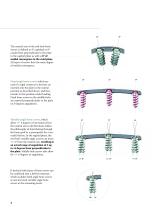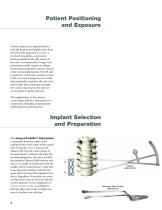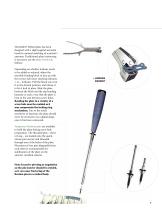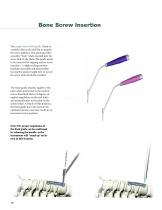 Website:
Stryker
Website:
Stryker
Group: Stryker
Catalog excerpts

Reflex® Hybrid Surgical Technique Anterior Cervical Plating System
Open the catalog to page 1
Patient Positioning and Exposure 6 Implant Selection and Preparation 6 Bone Screw Hole Preparation 8 Bone Screw Insertion 10 Bone Screw Removal 18 Anterior cervical discectomy and fusion remains one of the most successful surgical procedures, and the application of a plate to provide temporary postoperative stability has gained widespread acceptance as the “gold standard” of care. Anterior cervical plating systems continue to evolve and incorporate contemporary biomechanical understanding of the demands placed on these devices. Currently available anterior cervical...
Open the catalog to page 2
The Reflex® Hybrid ACP System offers a low-profile anterior cervical plate along with a selection of bone screw types to allow for a wide variety of constructs. Depending on the component combination, the system can accommodate both semi-constrained and rigid bone screw fixation philosophies. Instrument options further enhance surgical technique versatility by matching surgeon preference regarding approach and screw pathway preparation. The Reflex® Hybrid plate, made from a Ti-6Al-4V alloy, is 2.1mm thick to help reduce soft tissue irritation and may provide a suitable option for small...
Open the catalog to page 3
The neutral axis of the end-hole bone screws is defined as 8° cephalad or 8° caudal from perpendicular to the plate in the sagittal plane as well as 8° of medial convergence in the axial plane. All types of screws have the same degree of medial convergence. Fixed angle bone screws, which are used if a rigid construct is desired, are inserted into the plate in the neutral position as described above, and they remain in this position under loading. Fixed bone screws in the middle holes are inserted perpendicularly to the plate (at 0 degrees angulation). Variable angle bone screws, which allow...
Open the catalog to page 4
Both fixed and variable screws are offered as self-tapping, which feature a cutting flute and a less aggressive screw tip, and self-drilling, which have been designed with a sharp tip for insertion without prior drilling. The individual screw families have been Screw Type Variable Angle Fixed Angle color coded for easy identification: 4.0mm Self-Tapping 4.5mm Self-Tapping l^i“ ir/LiVl'A j-r^r-T r' The Reflex® Hybrid plates and screws represent a complete system, which is separate and not interchangeable with the original Reflex™ ACP system implants. Refer to the indications...
Open the catalog to page 5
Patient Positioning and Exposure Patient is placed in a supine position with the head turned slightly away from the side of the approach. For one- or two-level procedures, a transverse incision parallel to the skin creases of the neck is recommended. Longer level procedures usually require an oblique incision placed along the anterior border of the sternocleidomastoid. The left side is preferred, as the more constant course of the recurrent laryngeal nerve on this side potentially minimizes the risk of its injury. After blunt dissection through the various tissue layers, the anterior...
Open the catalog to page 6
The Reflex® Hybrid plate has been designed with a slight sagittal and axial bend for optimal matching of a patient’s anatomy. If additional plate contouring is necessary, use the plate bender as follows: Depending on whether lordosis needs to be added or reduced, adjust the movable bending block to face up with the correct side (laser marking indicates + or - lordosis). Pull the block out, turn it to the desired position, and release it to let it lock in place. Slide the plate between the block and the top bending hammer in such a way that the plate is bent in the area between screw...
Open the catalog to page 7
Screw Hole Preparation Depending on the type of a screw selected for a particular procedure, the following options are available for screw hole preparation. Single Barrel Double Barrel Screw insertion Screw insertion Screw insertion In all procedures above, optional tapping would precede screw insertion, if desired. Note: To ensure proper locking of the bone screws, freehand insertion of the bone screws is not recommended and can result in backout of bone screws if not properly aligned. 8 Screw insertion
Open the catalog to page 8
While certain instruments - such as the awl, drills, tap, and the screwdriver - are used for all types of bone screws, the drill guides and punch awl must correspond to whether fixed or variable angle bone screws will be implanted. The variable and fixed angle guides can be identified by their blue and purple handles, respectively. The punch awl handle is not screw-specific; however, the fixed and variable angle awl sleeves can be identified by the appropriate laser marking. Both the fixed and the variable angle guide instruments direct the screw trajectory within the range that ensures...
Open the catalog to page 9
Bone Screw Insertion The single-barrel drill guide (fixed or variable) directs the drill bit to prepare the screw pathway. The guide provides a positive “lock” when inserted into the screw hole in the plate. The guide needs to be removed for tapping and/or screw insertion. A slight rocking motion facilitates assembly and disassembly; forcing the guide straight into or out of the screw hole should be avoided. The fixed guide attaches rigidly to the plate when positioned in the neutral axis as described above (8 degrees of sagittal angulation on the end holes, and perpendicular to the plate...
Open the catalog to page 10
The double-barrel drill guide (fixed or variable) allows for both screw holes at a certain plate level to be prepared at the same time. The barrels are directed at 8 degrees of convergence for both screw types (fixed and variable); while the variable guide allows for sagittal angulation, the fixed guide is positioned rigidly in the neutral axis. Rocking the instrument from left to right facilitates assembly, i.c. attaching the left barrel first and then allowing the right barrel to come into position. Reversing the motion will ensure smooth disengagement of the guide. Similarly to...
Open the catalog to page 11All Stryker catalogs and technical brochures
-
VariAx® DistalFibula
20 Pages
-
ACCOLADE® II
20 Pages
-
VariAx® 2
20 Pages
-
TruRize® Clinical Chair
2 Pages
-
TruRize™ Clinical Chair
4 Pages
-
Prime TC®
4 Pages
-
ENT navigation system
7 Pages
-
Smart Equipment Management
3 Pages
-
OrthoMap®
4 Pages
-
AxSOS 3® Titanium
36 Pages
-
Luxor
4 Pages
-
Humeral Nailing System
44 Pages
-
AVS Anchor® -C
2 Pages
-
Aviator™
2 Pages
-
Aero® -C
6 Pages
-
Stryker Biologics
46 Pages
-
Escalate®
16 Pages
-
Dynatran
13 Pages
-
OASYS®
44 Pages
-
SurgiCount
4 Pages
-
Reusable Cuff
2 Pages
-
Disposable Cuff
2 Pages
-
SmartPump
2 Pages
-
Patient Education
2 Pages
-
Revolution
6 Pages
-
Cast Vac
2 Pages
-
Cast Cutter
2 Pages
-
Stryker NAV3i
4 Pages
-
S3 MedSurg Bed
8 Pages
-
Asnis ® Micro Xpress
2 Pages
-
EasyClip
2 Pages
-
Universal Neuro III
10 Pages
-
Right Angled Screwdriver
8 Pages
-
Neptune E-SEP
2 Pages
-
Neptune 2
2 Pages
-
InterPulse - Orthopaedics
4 Pages
-
Mixevac III
2 Pages
-
System 7 Family
7 Pages
-
SDC 3
2 Pages
-
SmartTip ™
3 Pages
-
Label Changes
2 Pages
-
Gamma3 T
6 Pages
-
the Mill
2 Pages
-
CBC II
2 Pages
-
Scorpio ®Knee TS
6 Pages
-
GMRS
13 Pages
-
trident
12 Pages
-
Gamma3 U-Blade Lag Screw
18 Pages
-
Gamma3 Fragment Control Clip
6 Pages
-
Gamma3 Long Nail R2.0
48 Pages
-
Gamma3 Trochanteric Nail 180
48 Pages
-
CD4 & SABO2 Family
5 Pages
-
System 7 Sterilization Case
2 Pages
-
System 7 Battery
2 Pages
-
System 7 Precision
2 Pages
-
System 7
7 Pages
-
ACL Instrumentation Brochure
6 Pages
-
C-Arm T racking System
2 Pages
-
company overview
12 Pages












































































